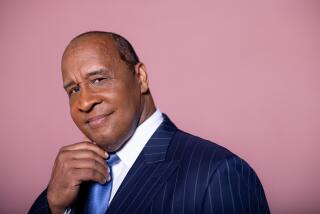Refusal to Correct Census Figures Upsets Inglewood : Population: Minorities were more likely to be overlooked, U.S. officials admit. Undercount will mean a loss of funds for city programs and services.
One of every 10 Inglewood residents--about 13,400 people--is not officially an Inglewood resident. Or at least as far as the 1990 census is concerned.
Although the U.S. Census Bureau acknowledges that it missed that many people in its head count last year, Commerce Secretary Robert A. Mosbacher announced this week that the government would not use statistical adjustments to increase the city’s population.
That means Inglewood--which had the biggest percentage undercount of any city in the nation--will lose an estimated $1 million a year over the next decade in state and federal monies that is distributed on the basis of population figures, city officials say.
“What is the purpose of the Census Bureau?” asked Councilman Jose Fernandez. “If their job is to count the people, why would they put out numbers they know are wrong? They are perpetrating a falsehood. They are saying the numbers that are not accurate are accurate. They are hurting the people who need the most help.”
Adjusting census figures would make the numbers more accurate in some cities but less so in others, Mosbacher said. Either way, he reasoned, some American cities were bound to go away mad.
Census officials also acknowledged that they were more likely to overlook minority residents than whites. According to bureau statistics, the 1990 head count missed 1.7% of whites, while failing to count 4.8% of blacks, 5.2% of Latinos, 5% of American Indians and 3.1% of Asian-Pacific Islanders.
Because 94% of Inglewood’s population is made up of minorities, city officials knew from the outset that its predominantly black and Latino residents would be undercounted.
To minimize the damage, the city spent $60,000 on census promotions. Still, city officials complained that they could not budge the census bureaucracy. Toll-free numbers set up by the Census Bureau for Latinos were often busy for days, and Spanish-speaking enumerators were hard to find.
To communicate with residents, English-speaking census workers had to resort to using Spanish-language flash cards, city officials complained. One census worker told a reporter after visiting homes in a Latino neighborhood: “With a few ‘ Como se llama? ‘ and ‘ Cuantas personas? ‘ we got through it.” She said she had last spoken Spanish as a student at Purdue University in the 1940s.
Community leaders say many recent Latino immigrants were reluctant to provide information to the government for fear of deportation. Despite assurances of confidentiality, many were afraid that the personal data would end up in the hands of the Immigration and Naturalization Service or city inspectors cracking down on illegal garage conversions.
City officials argue that the undercounted will essentially lose their representation in government. But, they concede, the primary issue is dollars and cents: The city estimates it receives about $70 a person in state and federal funds.
“We are not going to lose any money we are now getting,” said Assistant City Manager Norm Cravens. “We just should be getting more money based on the number of people we are serving. We won’t get our fair share.”
The undercount will affect federal transportation money that funds a van service for senior citizens, a downtown shopping shuttle and bus pass subsidies for seniors, and job training participants. Also reduced will be state money for street maintenance and state tax funds that support the city’s Police and Fire departments, parks and libraries.
Inglewood’s undercount was estimated at 10.9% in the follow-up to the census known as the post enumeration survey, which canvassed 171,390 homes nationwide. No other city came close. Moreno Valley in Riverside County had the second-highest undercount at 6.5%, whereas Santa Ana, Los Angeles and Washington had undercounts just above 5%.
The survey results only included cities with populations over 100,000. Torrance, the only other South Bay city on the list, had a 1990 census population of 133,107 and an estimated undercount of 1.4%.
Rep. Mervin M. Dymally (D-Compton) said the Census Bureau’s failure to accurately count blacks and Latinos will hurt the communities that need the most financial help.
“The undercount is going to be very devastating for Inglewood, Compton and a number of areas,” he said. “They will be paying for the undercount for the next 10 years. It will be a very high cost.”
Inglewood plans to join Los Angeles, New York and other big cities in a lawsuit to force the government to use statistical adjustments. A settlement to a previous lawsuit filed by the nation’s largest cities after the 1980 census gave Mosbacher the authority to decide whether the Bush Administration would correct the 1990 numbers.
As pressure mounted this week from Democratic leaders and the mayors of miscounted cities, Mosbacher announced to a House subcommittee that he would be willing to consider using estimates in the future to adjust allocation of federal funds, but not the census numbers themselves.
Such a move could be implemented within the next few years, Mosbacher said.
More to Read
Sign up for Essential California
The most important California stories and recommendations in your inbox every morning.
You may occasionally receive promotional content from the Los Angeles Times.










